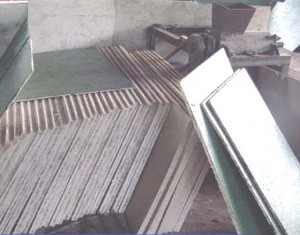 Coconut Fiber-Cement Board (CFB) is a panel manufactured from the mixture of fibrous materials like coconut coir or shredded woody portion of coconut tree and Portland cement at a ratio of 60-70% cement to 30 -40% fiber by weight. It is made by forming the cement-fiber mixture into mats and pressing them to the desired thickness.
Coconut Fiber-Cement Board (CFB) is a panel manufactured from the mixture of fibrous materials like coconut coir or shredded woody portion of coconut tree and Portland cement at a ratio of 60-70% cement to 30 -40% fiber by weight. It is made by forming the cement-fiber mixture into mats and pressing them to the desired thickness.
Research studies conducted at PCA-ZRC have shown that CFB panels have good strength properties and high dimensional stability when soaked in water (water absorption of 32% and thickness swelling of 4.2%) surpassing the minimum requirements set by PHILSA-Standard 105-1975. It has low thermal conductivity (k-value 0f 0.90 W/mk) which indicates its excellent insulation properties, thus it can be used as roofing materials even without ceiling. Flame test showed that, while the board can be burned, it is rather slow with minimal smoke emission.
Exposure test of paint-coated CFB roof sheets has demonstrated their capability to withstand the deleterious effect of weathering found in actual service condition.
Commercial production of CFB is expected to contribute to the government’s national shelter program, specifically on socialized and low-cost housing. CFB can replace construction materials such as tiles, bricks, plywood, asbestos and cement hollow blocks. It is used for internal and exterior walls, partitions and ceiling. It can also be used as a component in the fabrication of furniture, cabinets, boxes and vases, among others. Potential market outlets are construction material suppliers, building contractors and government/private agencies involved in low-cost housing projects. Other target markets are the low and middle-income households who would like to own houses at affordable prices.
How to make Coconut Fiber Cement Board
EQUIPMENT/MACHINERY
The major equipment used in the manufacture of CFB are all fabricated locally except the lifter and include the following:
- Decorticating machine
- Hydraulic press
- Blending machine
- Trimming machine
- Lifter
MANUFACTURING PROCESS OF CFB
Coconut fiber cement boards were produced based on the steps described below. There are three major components in the manufacture of coco fiber-wood-cement board, namely, (a) coconut residues consisting of husk, spathe, peduncle, petiole and leaf sheathe, (b) wood excelsior and (c) cement.
1. Processing of coconut fiber residues
- Cutting the spathe, peduncle, petiole and leaf sheath into 42 cm long.
- Soaking of husk, spathe, peduncle, petiole and leaf sheath in tap water for 18 to 24 hours.
- Decorticating separately the saturated husk, spathe, peduncle and leaf sheath to produce fiber and dust. Only fiber is used in board production while the dust may be used as soil conditioner.
- Shredding the petiole to produce curled shavings.
2. Soaking the coconut fiber and shavings in separate dipping tanks (each tank with a capacity of 12 cu. m.) full of water for two days to leach out extractive.
3. Collecting the coconut fiber and shavings from the dipping tanks and allowing water to drain from the residues and excelsior for about 5 minutes.
4. Weighing separately the fiber and cement with a ratio of 30 % coconut fibers and 70% cement.
5. Mixing separately the required amount of coconut fiber and excelsior with cement in a blending machine.
6. Mat forming using wooden forming boxes and flat steel cauls lined with polyethylene sheets. Three layers of mat are formed to produce a CFB. The first layer is a mixture of shavings and cement, the second is a mixture of coconut fiber and cement, and the last layer is the same mixture as in the first layer. Viewed In cross-section, the coconut fiber layer is embedded in-between the excelsior layers. The coconut fiber serves as reinforcement to improve the strength properties of the board.
7. Pressing the mat to the desired thickness-using guide bars, hydraulic press and clamping apparatus. Twenty-five layers of CFB can be pressed at the same time for approximately 10 minutes and then securely clamped or fastened using wooden moulds, bolts and nuts that serve as clamping apparatus.
8. The fastened/clamped CFB is removed from the hydraulic press and another set of 25 layers CFB is again prepared for pressing following steps 7 and 8. About six pressing operations can be attained per day giving a daily output of 150 boards.
9. After 18 to 20 hours under pressure, the boards are removed from the clamping apparatus and properly piled using 25 cm x 25 cm x 60 cm wooden sticks to provide air circulation (fillet-stacking) during the initial 24-hour air drying and conditioning.
10. Trimming the edges of the boards to the desired dimensions.
11. Fillet-stacking for further drying and conditioning for about one week.
For more information contact:
PCA-Zamboanga Research Center
San Ramon, 7000 Zamboanga City
Tel/Fax 062-982030
E-mail: [email protected]
NEDA Region IX
Phone Number: (062)9916741
Fax Number: (062)9911364
Email: [email protected]
Visit Website (This link will open on a new window)
How much weight or pressure needed on hydraulic press for pressing the CFB?